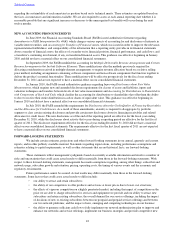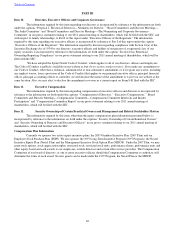Sprint - Nextel 2010 Annual Report Download - page 43
Download and view the complete annual report
Please find page 43 of the 2010 Sprint - Nextel annual report below. You can navigate through the pages in the report by either clicking on the pages listed below, or by using the keyword search tool below to find specific information within the annual report.
performed, are based on our current business and technology strategy, views of growth rates for our business, anticipated future
economic and regulatory conditions and expected technological availability. During 2010, we analyzed long-lived assets in our
Wireless segment for recoverability and, based on our estimate of undiscounted cash flows, determined the carrying value to be
recoverable. Our estimate of undiscounted cash flows exceeded the carrying value of these assets by more than 10%. If we
continue to have operational challenges, including obtaining and retaining subscribers, future cash flows of the Company may
not be sufficient to recover the carrying value of our wireless asset group, and we could record asset impairments that are
material to Sprint's consolidated results of operations and financial condition.
In addition to the analyses described above, certain assets that have not yet been deployed in the business, including
network equipment, cell site development costs and software in development, are periodically assessed to determine
recoverability. Network equipment and cell site development costs are expensed whenever events or changes in circumstances
cause the Company to conclude the assets are no longer needed to meet management's strategic network plans and will not be
deployed. Software development costs are expensed when it is no longer probable that the software project will be deployed.
Network equipment that has been removed from the network is also periodically assessed to determine recoverability. If we
continue to have challenges retaining subscribers and as we continue to assess the impact of rebanding the iDEN network,
management may conclude in future periods that certain CDMA and iDEN assets will never be either deployed or redeployed,
in which case non-cash charges that could be material to our consolidated financial statements would be recognized.
Evaluation of Goodwill and Indefinite-Lived Intangible Assets for Impairment
Goodwill represents the excess of purchase price paid over the fair value assigned to the net tangible and identifiable
intangible assets of acquired businesses. Sprint evaluates the carrying value of goodwill annually or more frequently if events
or changes in circumstances indicate that the carrying amount may exceed estimated fair value. Our analysis includes a
comparison of the estimated fair value of the reporting unit to which goodwill applies to the carrying value, including goodwill,
of that reporting unit.
We regularly assess whether any indicators of impairment exist, which requires a significant amount of judgment.
Such indicators may include a sustained significant decline in our share price and market capitalization; a decline in our
expected future cash flows; a significant adverse change in legal factors or in the business climate; unanticipated competition;
the testing for recoverability of a significant asset group within a reporting unit; and/or slower growth rates, among others. Any
adverse change in these factors could result in an impairment that could be material to our consolidated financial statements.
The determination of the estimated fair value of the wireless reporting unit requires significant estimates and
assumptions. These estimates and assumptions primarily include, but are not limited to, transactions within the wireless
industry and related control premiums, discount rate, terminal growth rates, operating income before depreciation and
amortization (OIBDA) and capital expenditures forecasts. Due to the inherent uncertainty involved in making those estimates,
actual results could differ from those estimates. The merits of each significant assumption, both individually and in the
aggregate, used to estimate the fair value of a reporting unit are evaluated for reasonableness.
FCC licenses and our Sprint and Boost Mobile trademarks have been identified as indefinite-lived intangible assets,
in addition to goodwill, after considering the expected use of the assets, the regulatory and economic environment within which
they are being used, and the effects of obsolescence on their use. When required, Sprint assesses the recoverability of other
indefinite-lived intangibles, including FCC licenses which are carried as a single unit of accounting. In assessing recoverability
of FCC licenses, we estimate the fair value of such licenses using the Greenfield direct value method, which approximates
value through estimating the discounted future cash flows of a hypothetical start-up business. Assumptions key in estimating
fair value under this method include, but are not limited to, capital expenditures, subscriber activations and deactivations,
market share achieved, tax rates in effect and discount rate. A one percent decline in our assumed revenue growth rate used to
estimate terminal value, a one percent decline in our assumed net cash flows or a one percent adverse change in any of the key
assumptions referred to above would not result in an impairment of our FCC licenses as of the most recent testing date. A
decline in the estimated fair value of FCC licenses of approximately 20% also would not result in an impairment of the carrying
value.
Accruals for Taxes Based on Income
Uncertainties exist with respect to interpretation of complex U.S. federal and state tax regulations. Management
expects that Sprint's interpretations will prevail. Also, Sprint has recognized deferred tax benefits relating to its future
utilization of past operating losses. Sprint believes it is more likely than not that the amounts of deferred tax assets in excess of
the related valuation allowances will be realized.
The accounting estimates related to the tax valuation allowance require us to make assumptions regarding the timing
of future events, including the probability of expected future taxable income and available tax planning opportunities. These
assumptions require significant judgment because actual performance has fluctuated in the past and may do so in the future.
The impact that changes in actual performance versus these estimates could have on the realization of tax benefits as reported
in our results of operations could be material.
The accounting estimates related to the liability for unrecognized tax benefits require us to make judgments
Table of Contents
41
























